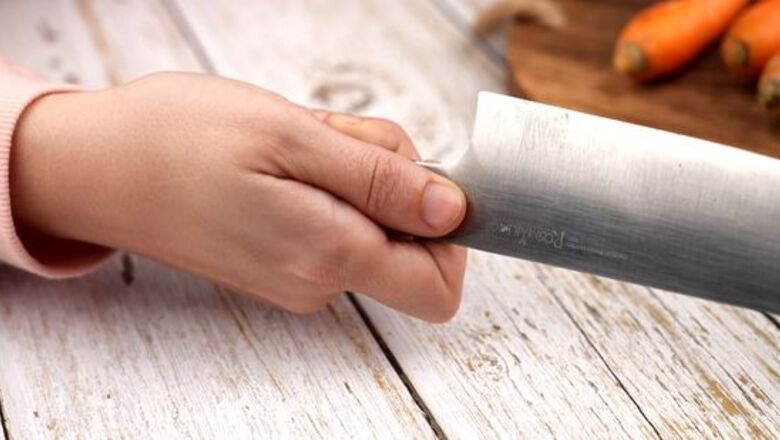
views
If you're interested in using knives for survival, throwing knives, fighting with knives, carving, working leather, or other related activities outside of the kitchen, read the linked wikiHow articles for guidance.
Using Kitchen Knives
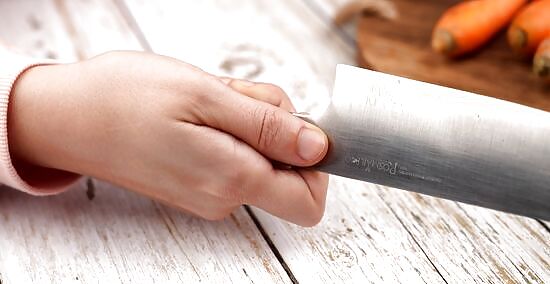
Learn to hold the knife correctly. Hold a kitchen knife as if you were going to shake hands with the handle. When you pick up a kitchen knife, your index finger should be on the outside of the blade, on the flat side, and your other three fingers should be choked up to the top of the handle, just at the blade. It should be parallel to your body. This is called the pinch grip, and it's the proper way to hold a kitchen knife, offering optimum control and accuracy with your cuts. Because your fingers are closer to the blade, you can control it better and keep it going where you want it to go. When you're holding the knife, keep the tip and the blade pointed down at all times to be on the safe side. Kitchen knives should be kept extremely sharp, so be careful around them. Many inexperienced cooks, when picking up a knife, will use a "hammer grip," in which all four fingers are wrapped around the handle, and the blade sticks straight out, perpendicular from the body. You shouldn't look like Jason from Friday the 13th when you're holding a kitchen knife.
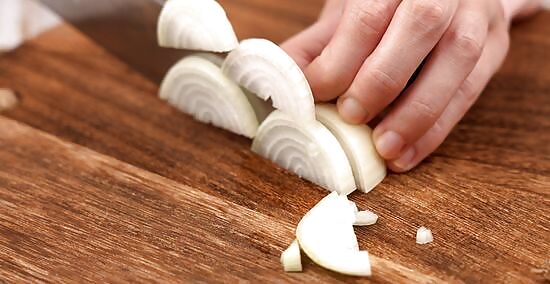
Learn to chop properly. The first step in learning to use a kitchen knife properly is in getting the chop down. While there are a few different styles of chopping food, there are a few basic guidelines that beginners can learn to follow easily. Learning to keep your guiding fingers safely tucked away and make safe cuts is absolutely essentially to kitchen safety. In the tip-fulcrum method of chopping, the tip of your knife will never really leave the cutting board. You'll use the tip as a fulcrum, to raise the blunt end of the blade up and down, firmly pushing the knife downward into the food you're chopping. In the wrist-fulcrum method, the black side of the blade, near where you're gripping, will never leave the cutting board, and the point will go up and down from the back pivot point, to cut through the food. This is commonly used when slicing onions or other vegetables. Never slap your knife onto the cutting board through a vegetable. There's no reason to do this, it's dangerous, and you'll dull the blade.

Learn to guide the food properly. Hold the knife in your dominant hand and make your other hand into a claw, fingers curled inward. Practice with a carrot or an onion, and place your claw on top of the food you're chopping. Place the flat side of the blade against the knuckles of your claw, with your knuckles tucked under and out of the way. Guide the food under the knife with your claw hand and pivot the blade with your cutting hand. Many chefs like to make a show of being able to do this very quickly. It looks dangerous and seems fancy. While it is the "proper" method of chopping, having your guide fingers so close to the knife makes many cooks nervous. It is safer than having your fingers out and exposed, but it takes some practice to get used to. Do what feels comfortable and go slow until you get more experienced.
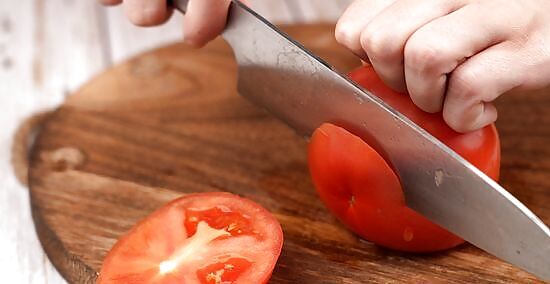
Learn to top and tail. Trying to cut oblong or rounded produce can be dangerous, which is why it's common practice to create a flat working surface from which to chop, dice, or make whatever cut you need to make on your vegetables and fruits. "Topping and tailing" refers to the practice of cutting off the bottom and top ends, which are sometimes somewhat dried out or thin, of produce, to create a flat surface to work from. Potatoes, tomatoes, onions, and other rounded fruits and vegetables all should be topped and tailed before you get started. Hold the vegetable firmly on its side, and slice the ends off, then discard them. It's usually then common to cut a tomato, say, in half from flat side to flat side, then chop or dice up each half individually.
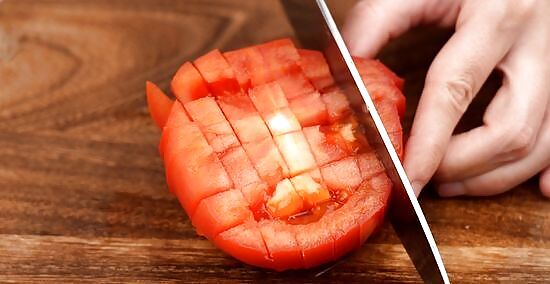
Use the dice for smaller, more uniform pieces. Chopped vegetables are cut into bite-sized chunks, while diced vegetables are much smaller, usually a few centimeters square. A good dice is usually fairly uniform, which can be accomplished by scoring vegetables and fruits through before cutting them at a perpendicular angle. Score vegetables in two directions, at an even interval, then dice by working your knife through the food at a perpendicular angle to your scoring.
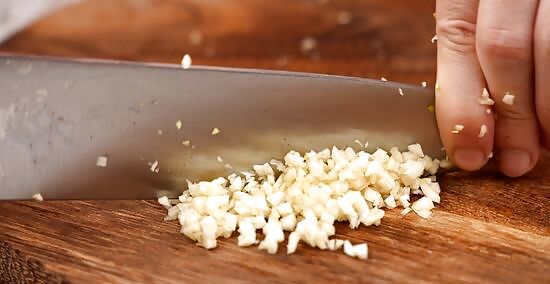
Mince vegetables to dissolve them. Mincing refers to cutting up tiny vegetables and other produce so small that it should dissolve in the pan when you cook it. Garlic is commonly minced. To mince something, you'll start by dicing it, then run your knife back and forth across the pile several times to get it as small as possible. The end result should be somewhere more coarse than a paste and way smaller than a dice.
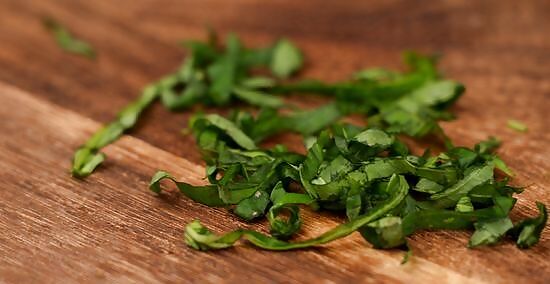
Chiffonade herbs and other greens. A chiffonade results in small uniform curls of greens and fresh herbs, and it's commonly used to slice up garnishes as a final touch for salads, soups, and roasted meat or pasta dishes. Spinach and basil are probably the most-common vegetables to chiffonade. It's much simpler than the fancy French name suggests. To chiffonade, you'll roll up each leaf of the vegetable you're cutting into a tight little roll, then chop at an even interval. It should result in pretty, even strips of green that you can use to top your dish.
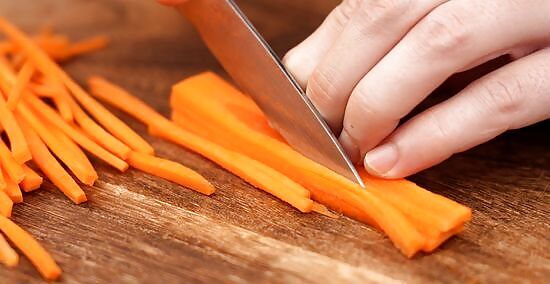
Julienne vegetables for garnishing. The julienne is one of the more advanced cuts you can learn, and it's, to some, a cool way to spice up a dish or make a garnish. Carrots, beets, cucumbers, and other root vegetables are commonly julienned. Vegetables need to be pretty firm to cut up. You probably wouldn't be able to julienne a tomato. Cut the food into 1/8th inch-thick planks of an even length, then stack the planks on top of one another and slice into thin strips. Each slice should be about the length of the space between the rivets on your knife.
Maintaining Knives
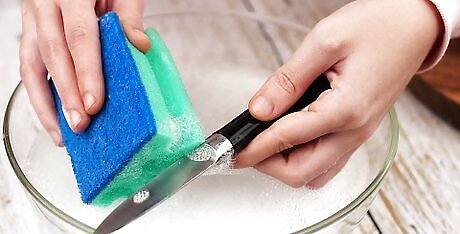
Clean knives with dish soap and warm water after use. Wipe down knives immediately after use with a clean towel to remove food bits and other gunk from the blade of the knife. The longer a knife remains wet and dirty the more the blade and the quality of the steel deteriorates. It's good to keep it clean and dry between uses. Wash knives individually, using hot soapy water and lots of care. Don't toss a big kitchen knife into the bottom of a wash basin so you'll have to fish around for it. Knives shouldn't need to soak for any reason. Don’t wash kitchen knives in the dishwasher, especially if the handle is made of wood, or some other kind of material that could become water-logged.
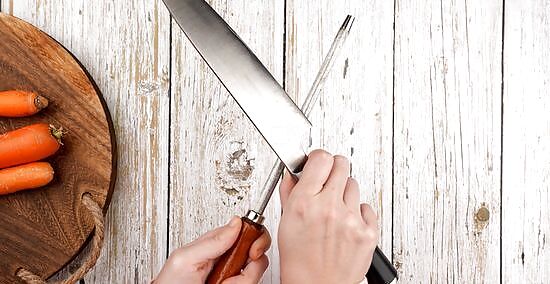
Hone your blades regularly. Honing a blade involves removing the nicks, burrs, and dings in the blade to recalibrate the angle of the edge. This needs to be done with a knife steel, at a 20 degree angle, on a regular basis. If you're using your knives in the kitchen regularly, it's a good idea to hone your blades after every use, or every couple of uses.
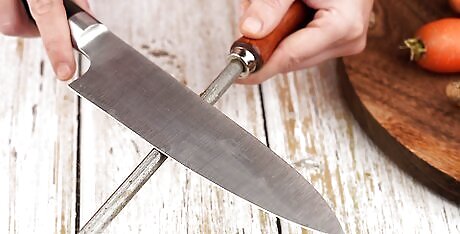
Sharpen knives about once a year. A dull knife is a dangerous knife. Kitchen knives need to be sharpened on a whetstone, at an angle of between 20 and 23 degrees. You can have your knives sharpened professionally for as little as a few dollars a knife, which is usually the best way to do it if you’ve got a few high-quality knives. Always sharpen blades in the same direction, using even pressure and long even strokes. If you're using your knife more often, it may be more appropriate to sharpen your knives regularly. If you're chopping up carrots with your kitchen knife every day, you should be able to keep it usable by honing it regularly, but you might need to have it sharpened every couple of months. A sharp kitchen knife should be able to cut through a piece of paper easily. If your knives are dull, the risk of glancing off of slippery vegetables and into your hand is much higher, making it important to work only with sharp knives. Dull knives are still sharp enough to cut your finger, which makes them a lot more dangerous. Always use a sharpener specifically designed for the material your blades are made from.
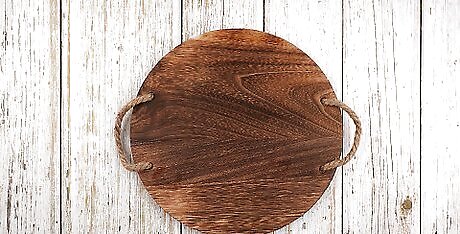
Use wood or plastic cutting boards. Chopping onto a slate or granite counter top is a fast-track to dinged up knives that you'll do a lot of damage to, never mind how you'll dink up your nice surfaces. Chopping on wood or plastic cutting boards is the best way to keep your knives in good working order.
Choosing the Right Knife
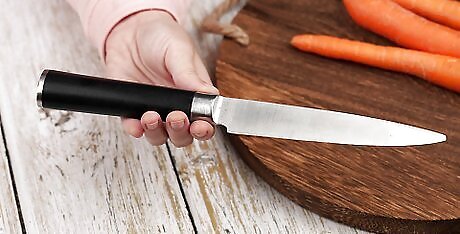
Invest in an all-purpose kitchen utility knife. If you've only got room for one knife in the kitchen, make it an all purpose knife. Good for chopping, slicing, and doing any number of other jobs, a good-quality utility kitchen knife is the most versatile tool you can have in the kitchen. Even if the rest of your tools are cheap and dull, a good kitchen knife will keep you cooking. There's no "best knife" or perfect knife for the kitchen. If you're in the market for a good set of knives, consider investing in a single good knife and other cheaper subsidiary knives. You can do most important cutting jobs in the kitchen with a basic kitchen knife, about 5 inches (12.7 cm) long, triangular, and made of stainless steel or other material.
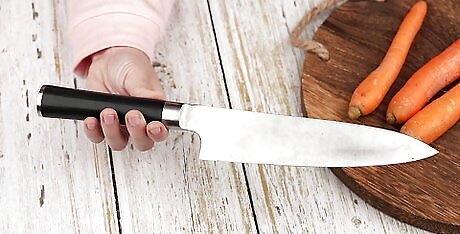
Use a chef’s knife for chopping, mincing, and dicing. Chefs' knives are also sometimes just referred to as "kitchen knives" and are heavy-duty blades. For some cooks, a good chefs' knife is the only slicing tool necessary in the kitchen, useful for doing careful small slices into fruit, smashing bulbs of garlic, and chopping onions, not much use for stirring though! Kitchen knives can be made from ceramic, steel or polycarbonate blends in a variety of styles. Western-style kitchen knives tend to be broader and more chopping-oriented, while Japanese-style kitchen knives are sleeker and typically stronger steel.
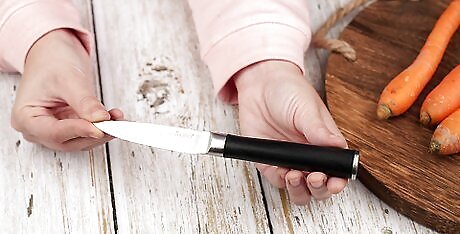
Use a paring knife for peeling fruits and vegetables. Paring knives are another extremely common kitchen implement, usually quite small and used for peeling and slicing, but won't usually be used for chopping or other major knife skills in the kitchen. Paring knives are good especially for fresh fruits, useful for cutting up an apple, pear, or stone fruits.
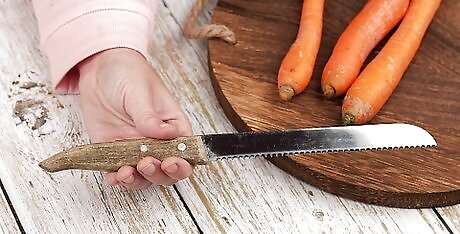
Use a bread knife for slicing. Serrated knives are particularly useful for slicing bread. There's nothing more frustrating than baking a hefty loaf of soft brown bread and smashing it with a kitchen knife, trying to slice it. A serrated knife is also excellent for carving roasted meat joints and other items, making it a helpful addition to the kitchen.
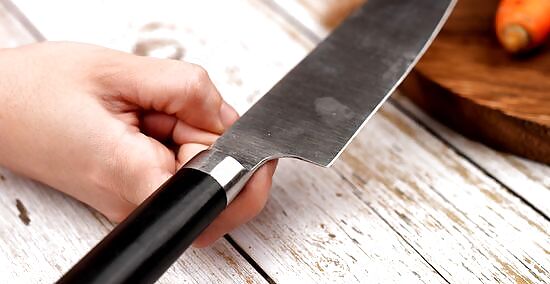
Select knives with good weight and balance. In a good utility kitchen knife, you want a good balance and weight between the blade and the tang, the steel that extends into the handle of the knife. The best knives should be made from a single piece of steel, and should be well-balanced. Check by trying to balance the knife on your finger, just at the top of the handle. It should feel dense in your hand, so you can let the knife do the work for you.










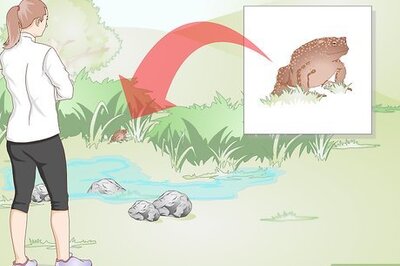









Comments
0 comment